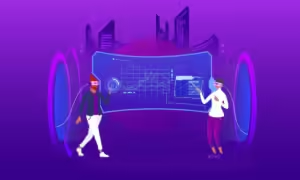Introduction to Test Automation
Testing is an indispensable aspect of software development, ensuring that applications meet quality standards, perform reliably, and deliver a seamless user experience. In traditional software development methodologies, testing often involves manual execution of test cases, a time-consuming and error-prone process. However, the advent of test automation revolutionized this landscape, enabling organizations to automate repetitive testing tasks, accelerate the testing process, and improve overall software quality.
A. Definition of Test Automation
Test automation refers to the use of software tools and frameworks to automate the execution of test cases, validation of expected outcomes, and reporting of test results. It involves the creation of scripts or test scenarios that mimic user interactions with the application under test, allowing for the systematic validation of various functionalities, performance metrics, and user interfaces.
B. Importance of Test Automation in Software Development
The importance of test automation in modern software development cannot be overstated. By automating repetitive and time-consuming testing tasks, organizations can significantly reduce the time to market for their products, enhance software quality, and optimize resource utilization. Test automation also facilitates continuous integration and continuous delivery (CI/CD) pipelines, enabling rapid and iterative development cycles while maintaining a high level of confidence in the software’s stability and reliability.
C. Evolution of Test Automation Techniques
Over the years, test automation techniques have evolved from simple script-based approaches to more sophisticated methodologies that leverage artificial intelligence (AI) and machine learning (ML) technologies. While traditional approaches rely on manual scripting and deterministic test cases, AI-driven test automation introduces a level of intelligence and adaptability that can revolutionize the way testing is conducted.
In the following sections, we will explore the role of AI in test automation, focusing on how machine learning algorithms can be leveraged to enhance the efficiency, effectiveness, and scalability of testing processes.
Traditional Approaches to Test Automation
In the realm of software testing, traditional approaches to test automation have long been the cornerstone for ensuring the quality and reliability of software products. These approaches typically involve scripting test cases to mimic user interactions with the software under test. Here, we delve into the various aspects of these conventional methodologies:
A. Script-based Test Automation:
Script-based test automation involves the creation of test scripts or code that instructs the software to perform specific actions and verifies expected outcomes. These scripts are typically written using programming languages like Java, and Python, or specialized test automation frameworks such as Selenium for web applications or Appium for mobile applications.
1. Script Development: Test scripts are meticulously crafted to cover various scenarios, functionalities, and edge cases of the software. This process requires in-depth knowledge of the application’s architecture, user workflows, and business requirements.
2. Maintenance Overhead: As the software evolves with new features and updates, test scripts must be continuously maintained to ensure their relevance and effectiveness. Any changes in the application’s user interface or functionality may require corresponding updates to the test scripts, adding to the maintenance overhead.
B. Challenges and Limitations of Script-based Approaches:
Despite their widespread adoption, traditional script-based approaches to test automation present several challenges and limitations:
1. Fragility: Test scripts are often tightly coupled with the application’s implementation details, making them fragile and prone to breakage with even minor changes in the software. This fragility necessitates frequent script updates, leading to increased maintenance efforts.
2. Time and Resource Intensive: Developing comprehensive test suites through script-based automation can be time-consuming and resource-intensive, particularly for complex software systems with extensive functionalities.
3. Limited Reusability: Test scripts developed for one application or version may not be easily reusable for testing other applications or subsequent versions. This lack of reusability diminishes the scalability and cost-effectiveness of test automation efforts.
C. Keyword-driven Testing Methodologies:
Recognizing the challenges posed by script-based approaches, keyword-driven testing methodologies have emerged as an alternative approach to test automation. In this approach, test cases are designed and executed using a set of predefined keywords or actions, abstracting the underlying implementation details.
1. Test Case Abstraction: Test cases are defined in terms of high-level keywords representing user actions, such as “login,” “search,” or “submit.” These keywords are mapped to corresponding functions or methods in the underlying test automation framework.
2. Improved Maintainability: By decoupling test cases from the underlying implementation, keyword-driven testing methodologies offer improved maintainability and flexibility. Changes to the application’s user interface or functionality can be accommodated by updating the keyword mappings without altering the test cases themselves.
3. Enhanced Collaboration: Keyword-driven testing promotes collaboration between testers, business analysts, and developers by providing a common language for describing and executing test cases. This collaborative approach fosters alignment between testing efforts and business requirements.
Introduction to AI in Test Automation
Test automation has long been recognized as a critical component of modern software development practices, enabling organizations to enhance efficiency, reduce time-to-market, and improve the overall quality of software products. However, as software systems become increasingly complex and dynamic, traditional approaches to test automation face significant challenges in keeping pace with the evolving demands of testing.
This is where Artificial Intelligence (AI) enters the scene, offering promising solutions to many of the limitations encountered in traditional test automation methods. AI brings forth a paradigm shift by enabling software testing processes to become more intelligent, adaptive, and efficient. In the context of test automation, AI refers to the utilization of various machine learning and advanced analytics techniques to enhance different aspects of the testing lifecycle.
One of the key advantages of integrating AI into test automation is its ability to deal with the intricacies and uncertainties inherent in modern software systems. Unlike conventional rule-based approaches, AI-driven testing methodologies can learn from historical data, adapt to changing conditions, and make informed decisions autonomously. This not only improves the effectiveness of testing but also enables organizations to identify and address potential issues more proactively.
Furthermore, AI facilitates the automation of tasks that were traditionally manual or labor-intensive, thereby freeing up valuable resources and allowing testing teams to focus on more strategic activities. For instance, AI-powered test case generation algorithms can automatically create diverse and comprehensive test scenarios based on the analysis of system requirements, code, and historical defect data.
Moreover, AI enables predictive analysis capabilities that help testing teams identify high-risk areas within the software under test, prioritize testing efforts, and allocate resources more efficiently. By leveraging machine learning models, organizations can predict potential defects, performance bottlenecks, and security vulnerabilities, thereby mitigating risks and ensuring a higher level of software quality.
Overall, AI holds immense potential to revolutionize the field of test automation, offering new opportunities for organizations to optimize their testing processes, accelerate time-to-market, and deliver software products that meet the highest standards of quality and reliability. In the subsequent sections, we will delve deeper into the various ways in which machine learning techniques can be leveraged to enhance different aspects of test automation, as well as the challenges and considerations associated with its adoption.
Leveraging Machine Learning for Test Automation
A. Test Case Generation using Machine Learning:
1. Introduction to test case generation: Traditionally, test cases are manually created based on requirements and user scenarios. Machine learning techniques can automate this process by analyzing historical data, identifying patterns, and generating test cases automatically.
2. Data-driven test case generation: Utilizing large datasets of past test cases, machine learning algorithms can learn from patterns and correlations to generate new test cases. This approach can help in achieving broader test coverage and uncovering edge cases that might be missed in manual test case creation.
3. Adaptive test case generation: Machine learning models can continuously learn from test results and adapt test cases based on feedback, improving the efficiency and effectiveness of the testing process over time.
B. Test Data Generation and Management:
1. Challenges with test data: Test data management is a crucial aspect of test automation, as the quality and relevance of test data significantly impact test coverage and effectiveness. However, generating diverse and realistic test data can be challenging and time-consuming.
2. Synthetic data generation: Machine learning techniques, such as generative adversarial networks (GANs) and deep learning models, can be employed to generate synthetic test data that closely resembles real-world scenarios. This approach enables testers to create large volumes of diverse test data quickly and efficiently.
3. Data augmentation: Machine learning algorithms can augment existing test data by introducing variations and mutations, thereby enhancing the diversity and coverage of test scenarios. This technique helps in identifying corner cases and improving the robustness of test suites.
C. Predictive Analysis for Identifying High-Risk Areas:
1. Importance of risk-based testing: Prioritizing testing efforts based on risk assessment is essential for optimizing resource utilization and ensuring maximum test coverage. Machine learning can aid in identifying high-risk areas within the software application by analyzing various factors, such as code complexity, historical defect data, and usage patterns.
2. Risk prediction models: Machine learning models can be trained using historical project data to predict potential areas of the application that are more likely to contain defects or issues. By leveraging predictive analytics, testers can focus their efforts on testing these high-risk areas first, thereby reducing the likelihood of critical defects escaping into production.
3. Continuous refinement: Machine learning-based risk prediction models can be continuously refined and updated based on new data and feedback from testing activities. This iterative process improves the accuracy and reliability of risk assessments over time, enabling teams to make more informed decisions regarding test prioritization and resource allocation.
Incorporating machine learning techniques into test automation processes empowers organizations to enhance test coverage, improve test efficiency, and identify critical defects early in the development lifecycle. By leveraging the predictive capabilities of machine learning, testers can optimize testing efforts and deliver higher-quality software products to market faster.
AI-driven Test Execution and Reporting
A. Intelligent Test Execution and Prioritization
1. Dynamic Test Prioritization: AI algorithms can dynamically prioritize test cases based on factors such as code changes, historical failure data, and criticality of functionalities. By intelligently prioritizing test cases, teams can focus on testing high-risk areas first, thereby optimizing testing efforts and resources.
2. Predictive Test Execution: AI-driven predictive models can anticipate potential failures by analyzing code changes, historical data, and environmental factors. This allows teams to proactively execute tests that are most likely to uncover defects, improving the efficiency of test execution and reducing time-to-market.
3. Adaptive Test Suites: AI algorithms can continuously adapt test suites based on evolving project requirements, code changes, and feedback from previous test runs. This adaptive approach ensures that the test suite remains relevant and effective throughout the software development lifecycle, even as the application undergoes iterative changes.
B. Real-time Test Monitoring and Feedback
1. Automated Test Monitoring: AI-powered monitoring tools can analyze test execution in real-time, detecting anomalies, performance bottlenecks, and unexpected behaviors. This real-time feedback enables teams to quickly identify and address issues during the testing process, improving the overall quality of the software.
2. Root Cause Analysis: AI algorithms can perform root cause analysis on test failures, identifying the underlying reasons behind defects and providing actionable insights for resolution. By pinpointing the root causes of failures, teams can expedite troubleshooting and prevent similar issues in future iterations.
3. Continuous Improvement: AI-driven test monitoring and feedback mechanisms facilitate continuous improvement by capturing metrics, trends, and patterns from test execution. This data-driven approach enables teams to iteratively enhance test coverage, effectiveness, and reliability over time, leading to higher-quality software products.
C. Automated Reporting and Analysis
1. Automated Test Result Analysis: AI-powered tools can automatically analyze test results, aggregating data from multiple test runs and generating comprehensive reports. These reports provide stakeholders with visibility into the overall health of the application, including test coverage, pass/fail rates, and defect trends.
2. Customizable Dashboards: AI-driven reporting platforms offer customizable dashboards that allow stakeholders to visualize key testing metrics and KPIs in real time. These dashboards can be tailored to specific roles and objectives, providing stakeholders with relevant insights to support decision-making and risk management.
3. Predictive Analytics for Quality Assurance: AI algorithms can leverage historical test data to predict future quality assurance trends, such as defect density, release readiness, and potential risks. By forecasting quality assurance metrics, teams can proactively mitigate risks, allocate resources effectively, and optimize the overall testing process.
Incorporating AI into test execution and reporting processes enables teams to enhance efficiency, accuracy, and effectiveness throughout the software development lifecycle. By leveraging AI-driven insights, teams can streamline test execution, improve defect detection, and accelerate time-to-market, ultimately delivering higher-quality software products to end-users.
Challenges and Considerations
Incorporating artificial intelligence (AI) into test automation undoubtedly offers numerous benefits, but it also comes with its own set of challenges and considerations that organizations need to address for successful implementation. Below are some key challenges and considerations:
1. Data Quality and Availability:
- One of the fundamental requirements for AI-based test automation is access to high-quality and diverse datasets.
- Ensuring the reliability and relevance of training data is crucial for the effectiveness of machine learning algorithms.
- In some cases, obtaining sufficient data for training AI models might be challenging, particularly for niche domains or applications with limited historical data.
2. Interpretability and Explainability:
- AI-driven testing often relies on complex machine learning algorithms, which can produce results that are difficult to interpret or explain.
- Understanding why a particular test case failed or why a certain prediction was made is essential for gaining trust in AI-driven testing systems.
- Striking a balance between the accuracy of AI models and the interpretability of their outputs is a significant challenge in AI-driven test automation.
3. Integration with Existing Processes and Tools:
- Integrating AI-based test automation tools and methodologies with existing testing processes and tools can be non-trivial.
- Compatibility issues, data format mismatches, and differences in workflows may arise during the integration process.
- Ensuring seamless interoperability between AI-driven testing solutions and established testing frameworks is essential for minimizing disruption and maximizing efficiency.
4. Resource and Expertise Requirements:
- Implementing AI-driven test automation requires specialized skills and resources, including data scientists, machine learning engineers, and domain experts.
- Building and maintaining AI models for test automation may necessitate significant investments in terms of time, money, and expertise.
- Organizations must assess their existing capabilities and determine whether they have the necessary resources and expertise to embark on AI-driven test automation initiatives.
5. Ethical and Regulatory Considerations:
- AI-based test automation raises ethical and regulatory concerns, particularly regarding data privacy, bias, and fairness.
- Ensuring that AI models are trained on unbiased and representative datasets is crucial for preventing algorithmic biases.
- Compliance with relevant regulations and standards, such as GDPR and ISO/IEC 25010, is essential to mitigate legal and reputational risks associated with AI-driven testing.
Addressing these challenges and considerations requires a concerted effort from software development teams, testing professionals, and organizational stakeholders. By proactively identifying and mitigating potential pitfalls, organizations can harness the power of AI to revolutionize test automation and enhance the quality and efficiency of software testing processes.
Conclusion
In conclusion, the integration of artificial intelligence (AI) into test automation marks a significant advancement in software development practices. By leveraging machine learning algorithms, AI-powered test automation offers several benefits, including enhanced efficiency, accuracy, and adaptability to dynamic testing environments.
Throughout this discussion, we have explored the various ways in which AI is transforming traditional test automation processes. From test case generation to intelligent test execution and reporting, AI brings a new level of sophistication and effectiveness to software testing.
However, it’s essential to recognize that the adoption of AI in test automation also comes with its challenges. Issues such as data quality, interpretability of results, and integration with existing tools require careful consideration and strategic planning.
Nevertheless, the case studies and examples presented demonstrate the tangible benefits that organizations can achieve by embracing AI-driven test automation. These successes highlight the importance of staying abreast of emerging technologies and adapting testing strategies accordingly.
Looking ahead, the future of test automation lies in continued innovation and refinement of AI-driven approaches. As AI technologies evolve and become more accessible, we can expect to see even greater advancements in software testing efficiency and effectiveness.
In summary, AI is poised to play an increasingly pivotal role in the future of test automation. By embracing AI-powered testing solutions and addressing associated challenges, software development teams can optimize their testing processes and deliver higher-quality software products to market faster than ever before.












